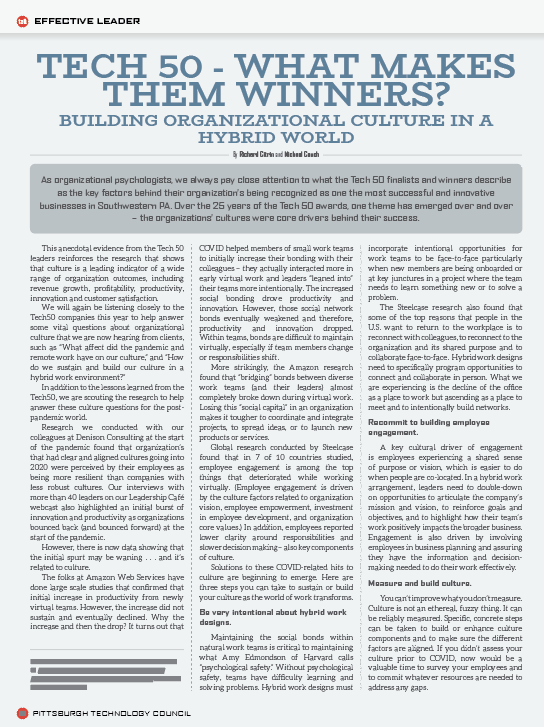Tech 50 - What Makes Them Winners?
By Richard Citrin and Michael Counch
 This anecdotal evidence from the Tech 50 leaders reinforces the research that shows that culture is a leading indicator of a wide range of organization outcomes, including revenue growth, profitability, productivity, innovation and customer satisfaction.
This anecdotal evidence from the Tech 50 leaders reinforces the research that shows that culture is a leading indicator of a wide range of organization outcomes, including revenue growth, profitability, productivity, innovation and customer satisfaction.
We will again be listening closely to the Tech50 companies this year to help answer some vital questions about organizational culture that we are now hearing from clients, such as “What affect did the pandemic and remote work have on our culture,” and “How do we sustain and build our culture in a hybrid work environment?”
In addition to the lessons learned from the Tech50, we are scouting the research to help answer these culture questions for the post-pandemic world.
Research we conducted with our colleagues at Denison Consulting at the start of the pandemic found that organization’s that had clear and aligned cultures going into 2020 were perceived by their employees as being more resilient than companies with less robust cultures. Our interviews with more than 40 leaders on our Leadership Café webcast also highlighted an initial burst of innovation and productivity as organizations bounced back (and bounced forward) at the start of the pandemic.
However, there is now data showing that the initial spurt may be waning . . . and it’s related to culture.
The folks at Amazon Web Services have done large scale studies that confirmed that initial increase in productivity from newly virtual teams. However, the increase did not sustain and eventually declined. Why the increase and then the drop? It turns out that COVID helped members of small work teams to initially increase their bonding with their colleagues – they actually interacted more in early virtual work and leaders “leaned into” their teams more intentionally. The increased social bonding drove productivity and innovation. However, those social network bonds eventually weakened and therefore, productivity and innovation dropped. Within teams, bonds are difficult to maintain virtually, especially if team members change or responsibilities shift.
More strikingly, the Amazon research found that “bridging” bonds between diverse work teams (and their leaders) almost completely broke down during virtual work. Losing this “social capital” in an organization makes it tougher to coordinate and integrate projects, to spread ideas, or to launch new products or services.
Global research conducted by Steelcase found that in 7 of 10 countries studied, employee engagement is among the top things that deteriorated while working virtually. (Employee engagement is driven by the culture factors related to organization vision, employee empowerment, investment in employee development, and organization core values.) In addition, employees reported lower clarity around responsibilities and slower decision making – also key components of culture.
Solutions to these COVID-related hits to culture are beginning to emerge. Here are three steps you can take to sustain or build your culture as the world of work transforms.
Be very intentional about hybrid work designs.
Maintaining the social bonds within natural work teams is critical to maintaining what Amy Edmondson of Harvard calls “psychological safety.” Without psychological safety, teams have difficulty learning and solving problems. Hybrid work designs must incorporate intentional opportunities for work teams to be face-to-face particularly when new members are being onboarded or at key junctures in a project where the team needs to learn something new or to solve a problem.
The Steelcase research also found that some of the top reasons that people in the U.S. want to return to the workplace is to reconnect with colleagues, to reconnect to the organization and its shared purpose and to collaborate face-to-face. Hybrid work designs need to specifically program opportunities to connect and collaborate in person. What we are experiencing is the decline of the office as a place to work but ascending as a place to meet and to intentionally build networks.
Recommit to building employee engagement.
A key cultural driver of engagement is employees experiencing a shared sense of purpose or vision, which is easier to do when people are co-located. In a hybrid work arrangement, leaders need to double-down on opportunities to articulate the company’s mission and vision, to reinforce goals and objectives, and to highlight how their team’s work positively impacts the broader business. Engagement is also driven by involving employees in business planning and assuring they have the information and decision-making needed to do their work effectively.
Measure and build culture.
You can’t improve what you don’t measure. Culture is not an ethereal, fuzzy thing. It can be reliably measured. Specific, concrete steps can be taken to build or enhance culture components and to make sure the different factors are aligned. If you didn’t assess your culture prior to COVID, now would be a valuable time to survey your employees and to commit whatever resources are needed to address any gaps.